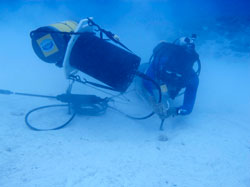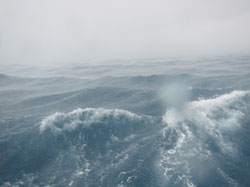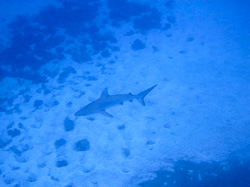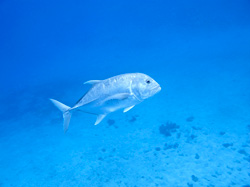
Reef Assessment and Monitoring Program Expediton Log – August 9, 2012
Adventure at Sea - Acoustics and Underwater Visitors!
By: Megan Onuma & Carlie Wiener, COSEE Island Earth
Today was another long-awaited field day, as scientists finally got out to Pearl and Hermes Atoll. Pearl and Hermes is a huge reef, with a few tiny sand islands protruding above the surface of the water. The rough seas, high winds, and rain squalls made for challenging conditions; however, the crew and scientists persevered through several location changes to keep everyone as safe as possible.
Today we followed the marine acoustics team, who had a full day of field work planned. Since the weather has been dicey, they needed to deploy all their equipment in case they could not get out again for a few days. Standing on the stern of the small boat Malolo, along with the marine acoustics scientists', we attempted the bumpy journey to the first dive site. After two transit days on the ship, we were all eager to get out into the ocean. The swells battered the bow of the boat, the wind whipped up into our faces, and the hard rain hit bare skin like hailstones. Nonetheless, not a single frown in sight.
After a few hours of carefully navigating through maze-like coral reef patches, we arrived at a suitable deployment site for the "EAR" (the Ecological Acoustic Recorder). Scientists use the EAR to monitor both biological sounds (animals, weather, and natural events) in the ocean environment. Monitoring the changing status of coral reef environments and their inhabitants is a critical management need and a considerable technological challenge, especially on reefs in remote locations, such as those in the Northwestern Hawaiian Islands. Understanding the interactions between species in coral reef communities requires long-term observation of relationships. The acoustics team, Lauren and Simon Freeman, readied their SCUBA gear to set up the EAR device on the sea floor. This EAR along with the other ones, including two deep water EARs that were deployed earlier on the trip (one at French Frigate Shoals and one at Pearl and Hermes), are out in the field for a set period of time before being recovered and having their acoustic data analyzed. By listening to the sounds that animals make underwater, scientists gain insight on what types of organisms are in the area and what their behavior patterns are like.
While working on the reef, a few locals stopped by to check out the action. Pearl and Hermes, known for its apex predators, stayed true to its character and we were visited by a gray reef shark and an ulua. This was one of the first sharks sighted in the Northwestern Hawaiian Islands on this trip so far. The three foot reef shark swam over to investigate the divers; but, the mega fauna fun was not over yet! As the divers rose up to their safety stop, a huge ulua (giant trevally), well over 80lbs, swam up to greet our team.

Simon Freeman deploys one of the acoustic listening devices on a sandy bottom at Pearl and Hermes Atoll. Credit: L. Freeman
On the next dive, Lauren and Simon brought down different acoustic equipment and fastened it using sand drills to the sandy, ocean floor. Scientists are very careful in where they place their equipment, ensuring that they or their equipment does not harm the reefs. Three different types of sound recording devices were secured to the bottom, along with a weighted camera array to take periodic pictures of the algae covered bottom. In a few days, the team will go out again to recover all of the equipment and explore the data that they have collected.
Driving back in the small boat from a full day of field operators to the NOAA ship, Hiʻialakai, was a skilled task. The labyrinth of shallow reefs at Pearl and Hermes makes for a difficult job, one which only the skilled and experienced coxswains' (boat drivers) know how to do. Thanks to good way finding and maneuvering, we made our way back to the ship safely. All in all, another great and productive day in the field!
Click here to go back to the Expedition Log.



